When Green Procurement Meets Complexity: The Case of Sustainable Neighborhood Projects
Abstract
1. Introduction
- How can green procurement support coordination in sustainable neighborhood programs?
- What are the implications for purchasers when devising a green procurement strategy for sustainable neighborhood programs?
2. Key Concepts and Theory
2.1. Program Management
2.2. Nearly Decomposable Systems
2.3. Procurement in Nearly Decomposable Programs
3. Data and Methods
3.1. Data Sources and Analysis
3.2. The Ydalir Project: Overview and Case Selection
4. Findings
4.1. System Architecture in Ydalir
4.2. The Organization of Procurement in Ydalir
4.3. The Many Faces of the Municipality
4.4. Dialogue-Oriented Procurements
4.4.1. Land and Housing Development
4.4.2. The School and Kindergarten
4.4.3. Mixed Housing Development
4.5. Masterplan-Oriented Procurements
5. Discussion
6. Conclusions
Author Contributions
Funding
Institutional Review Board Statement
Informed Consent Statement
Data Availability Statement
Acknowledgments
Conflicts of Interest
References
- Koch, A.; Girard, S.; McKoen, K. Towards a neighbourhood scale for low- or zero-carbon building projects. Build. Res. Inf. 2012, 40, 527–537. [Google Scholar] [CrossRef]
- Luederitz, C.; Lang, D.J.; Von Wehrden, H. A systematic review of guiding principles for sustainable urban neighborhood development. Landsc. Urban Plan. 2013, 118, 40–52. [Google Scholar] [CrossRef]
- Sharifi, A. From Garden City to Eco-urbanism: The quest for sustainable neighborhood development. Sustain. Cities Soc. 2016, 20, 1–16. [Google Scholar] [CrossRef]
- Grazieschi, G.; Asdrubali, F.; Guattari, C. Neighbourhood sustainability: State of the art, critical review and space-temporal analysis. Sustain. Cities Soc. 2020, 63, 102477. [Google Scholar] [CrossRef]
- Nielsen, B.F.; Baer, D.; Lindkvist, C. Identifying and supporting exploratory and exploitative models of innovation in municipal urban planning; key challenges from seven Norwegian energy ambitious neighborhood pilots. Technol. Forecast. Soc. Chang. 2019, 142, 142–153. [Google Scholar] [CrossRef]
- Shi, Q.; Yu, T.; Zuo, J.; Lai, X. Challenges of developing sustainable neighborhoods in China. J. Clean. Prod. 2016, 135, 972–983. [Google Scholar] [CrossRef]
- Davies, A.; Gann, D.; Douglas, T. Innovation in megaprojects: Systems integration at London Heathrow terminal 5. Calif. Manag. Rev. 2009, 51, 101–125. [Google Scholar] [CrossRef]
- Lycett, M.; Rassau, A.; Danson, J. Programme management: A critical review. Int. J. Proj. Manag. 2004, 22, 289–299. [Google Scholar] [CrossRef]
- Tanguy, A.; Breton, C.; Blanchet, P.; Amor, B. Characterising the development trends driving sustainable neighborhoods. Build. Cities 2020, 1, 164–181. [Google Scholar] [CrossRef]
- Cheng, W.; Appolloni, A.; D’Amato, A.; Zhu, Q. Green Public Procurement, missing concepts and future trends–A critical review. J. Clean. Prod. 2018, 176, 770–784. [Google Scholar] [CrossRef]
- Varnäs, A.; Balfors, B.; Faith-Ell, C. Environmental consideration in procurement of construction contracts: Current practice, problems and opportunities in green procurement in the Swedish construction industry. J. Clean. Prod. 2009, 17, 1214–1222. [Google Scholar] [CrossRef]
- Sterner, E. ‘Green procurement’ of buildings: A study of Swedish clients’ considerations. Constr. Manag. Econ. 2002, 20, 21–30. [Google Scholar] [CrossRef]
- Shen, L.; Zhang, Z.; Zhang, X. Key factors affecting green procurement in real estate development: A China study. J. Clean. Prod. 2017, 153, 372–383. [Google Scholar] [CrossRef]
- Kadefors, A.; Lingegård, S.; Uppenberg, S.; Alkan-Olsson, J.; Balian, D. Designing and implementing procurement requirements for carbon reduction in infrastructure construction–international overview and experiences. J. Environ. Plan. Manag. 2021, 64, 611–634. [Google Scholar] [CrossRef]
- Igarashi, M.; De Boer, L.; Michelsen, O. Investigating the anatomy of supplier selection in green public procurement. J. Clean. Prod. 2015, 108, 442–450. [Google Scholar] [CrossRef]
- Flyvbjerg, B. Survival of the unfittest: Why the worst infrastructure gets built--and what we can do about it. Oxf. Rev. Econ. Policy 2009, 25, 344–367. [Google Scholar] [CrossRef]
- Shenhar, A.J. One size does not fit all projects: Exploring classical contingency domains. Manag. Sci. 2001, 47, 394–414. [Google Scholar] [CrossRef]
- Zamora, E.C.; Carballo, Á.G. The failure of eco-neighborhood projects in the city of Madrid (Spain). Urban Sci. 2018, 2, 111. [Google Scholar] [CrossRef]
- Simon, H.A. The architecture of complexity. Proc. Am. Philos. Soc. 1962, 106, 467–482. [Google Scholar]
- Davies, A.; MacKenzie, I. Project complexity and systems integration: Constructing the London 2012 Olympics and Paralympics Games. Int. J. Proj. Manag. 2014, 32, 773–790. [Google Scholar] [CrossRef]
- Engwall, M.; Jerbrant, A. The resource allocation syndrome: The prime challenge of multi-project management? Int. J. Proj. Manag. 2003, 21, 403–409. [Google Scholar] [CrossRef]
- Brady, T.; Davies, A. Managing structural and dynamic complexity: A tale of two projects. Proj. Manag. J. 2014, 45, 21–38. [Google Scholar] [CrossRef]
- Tee, R.; Davies, A.; Whyte, J. Modular designs and integrating practices: Managing collaboration through coordination and cooperation. Res. Policy 2019, 48, 51–61. [Google Scholar] [CrossRef]
- Gray, R.; Bamford, P. Issues in programme integration. Int. J. Proj. Manag. 1999, 17, 361–366. [Google Scholar] [CrossRef]
- Orton, J.D.; Weick, K.E. Loosely coupled systems: A reconceptualization linked references are available on jstor for this article: Loosely coupled systems: A reconceptualization. Acad. Manag. Rev. 1990, 15, 203–223. [Google Scholar] [CrossRef]
- Glassman, R.B. Persistence and loose coupling in living systems. Syst. Res. Behav. Sci. 1973, 18, 83–98. [Google Scholar] [CrossRef]
- Parnas, D.L. On the criteria to be used in decomposing systems into modules. Commun. ACM 1972, 15, 1053–1058. [Google Scholar] [CrossRef]
- Yakob, R.; Tell, F. Managing near decomposability in complex platform development projects. Int. J. Technol. Intell. Plan. 2007, 3, 387. [Google Scholar] [CrossRef]
- Sanchez, R.; Mahoney, J.T. Modularity, flexibility, and knowledge management in product and organization design. Strat. Manag. J. 1996, 17, 63–76. [Google Scholar] [CrossRef]
- Ashby, W. Design for a Brain: The Origin of Adaptive Behaviour, 2nd ed.; Chapman and Hall: London, UK, 1960. [Google Scholar]
- Schilling, M.A. Toward a general modular systems theory and its application to interfirm product modularity. Acad. Manag. Rev. 2000, 25, 312–334. [Google Scholar] [CrossRef]
- Campagnolo, D.; Camuffo, A. The concept of modularity in management studies: A literature review. Int. J. Manag. Rev. 2009, 12, 259–283. [Google Scholar] [CrossRef]
- Colfer, L.J.; Baldwin, C.Y. The mirroring hypothesis: Theory, evidence, and exceptions. Ind. Corp. Chang. 2016, 25, 709–738. [Google Scholar] [CrossRef]
- Tee, R. Benefiting from modularity within and across firm boundaries. Ind. Corp. Chang. 2019, 28, 1011–1028. [Google Scholar] [CrossRef]
- Davies, A.; Macaulay, S.; DeBarro, T.; Thurston, M. Making innovation happen in a megaproject: London’s crossrail suburban railway system. Proj. Manag. J. 2014, 45, 25–37. [Google Scholar] [CrossRef]
- Hofman, E.; Halman, J.I.; Van Looy, B. Do design rules facilitate or complicate architectural innovation in innovation alliance networks? Res. Policy 2016, 45, 1436–1448. [Google Scholar] [CrossRef]
- Uttam, K.; Roos, C.L.L. Competitive dialogue procedure for sustainable public procurement. J. Clean. Prod. 2015, 86, 403–416. [Google Scholar] [CrossRef]
- Sparrevik, M.; Wangen, H.F.; Fet, A.M.; De Boer, L. Green public procurement–A case study of an innovative building project in Norway. J. Clean. Prod. 2018, 188, 879–887. [Google Scholar] [CrossRef]
- Igarashi, M.; De Boer, L.; Fet, A.M. What is required for greener supplier selection? A literature review and conceptual model development. J. Purch. Supply Manag. 2013, 19, 247–263. [Google Scholar] [CrossRef]
- Alhola, K.; Nissinen, A. Integrating cleantech into innovative public procurement process–evidence and success factors. J. Public Procure 2018, 18, 336–354. [Google Scholar] [CrossRef]
- Edquist, C.; Zabala-Iturriagagoitia, J.M. Public Procurement for Innovation as mission-oriented innovation policy. Res. Policy 2012, 41, 1757–1769. [Google Scholar] [CrossRef]
- Hamdan, H.A.M.; De Boer, L. Innovative public procurement (IPP)–Implications and potential for zero-emission neighborhood (ZEN) projects? In Proceedings of the 1st Nordic Conference on Zero Emission and Plus Energy Buildings, Trondheim, Norway, 6–7 November 2019; IOP Publishing: Bristol, UK, 2019; Volume 352, p. 12013. [Google Scholar]
- Yin, R.K. Case Study research and Applications: Design and Methods, 6th ed.; SAGE Publications, Inc.: California, CA, USA, 2018. [Google Scholar]
- Miles, M.; Huberman, A.; Saldana, J. Qualitative Data Analysis: A Methods Sourcebook, 3rd ed.; Sage Publications, Inc.: Thousand Oaks, CA, USA, 2014; ISBN 978-1452257877. [Google Scholar]
- Dubois, A.; Gadde, L.-E. Systematic combining: An abductive approach to case research. J. Bus. Res. 2002, 55, 553–560. [Google Scholar] [CrossRef]
- Elverum Kommune Anskaffelsesstrategi 2020–2023; Elverum Kommune: Elverum, Norway, 2020.
- Tomteselskap, E. Konseptutredning Ydalir–Sluttrapport til Enova. 2017. Available online: enova.no/bedrift/bygg-og-eiendom/tema/konseptutredninger/ydalir/ (accessed on 4 May 2020).
- Meehan, J.; Bryde, D. Sustainable procurement practice. Bus. Strat. Environ. 2011, 20, 94–106. [Google Scholar] [CrossRef]
- Caldwell, N.D.; Roehrich, J.K.; Davies, A.C. Procuring complex performance in construction: London Heathrow Terminal 5 and a Private Finance Initiative hospital. J. Purch. Supply Manag. 2009, 15, 178–186. [Google Scholar] [CrossRef]
- Williams, T. The need for new paradigms for complex projects. Int. J. Proj. Manag. 1999, 17, 269–273. [Google Scholar] [CrossRef]
- Gelderman, C.J.; Semeijn, J.; Bouma, F. Implementing sustainability in public procurement: The limited role of procurement managers and party-political executives. J. Public Procure 2015, 15, 66–92. [Google Scholar] [CrossRef]
- Jenssen, M.M.; De Boer, L. Implementing life cycle assessment in green supplier selection: A systematic review and conceptual model. J. Clean. Prod. 2019, 229, 1198–1210. [Google Scholar] [CrossRef]
- Davies, A.; Brady, T. Explicating the dynamics of project capabilities. Int. J. Proj. Manag. 2016, 34, 314–327. [Google Scholar] [CrossRef]
- Davies, A.; Brady, T. Organisational capabilities and learning in complex product systems: Towards repeatable solutions. Res. Policy 2000, 29, 931–953. [Google Scholar] [CrossRef]
- Orehounig, K.; Evins, R.; Dorer, V. Integration of decentralized energy systems in neighbourhoods using the energy hub approach. Appl. Energy 2015, 154, 277–289. [Google Scholar] [CrossRef]
- Vluggen, R.; Gelderman, C.J.; Semeijn, J.; Van Pelt, M. Sustainable public procurement—External forces and accountability. Sustainability 2019, 11, 5696. [Google Scholar] [CrossRef]
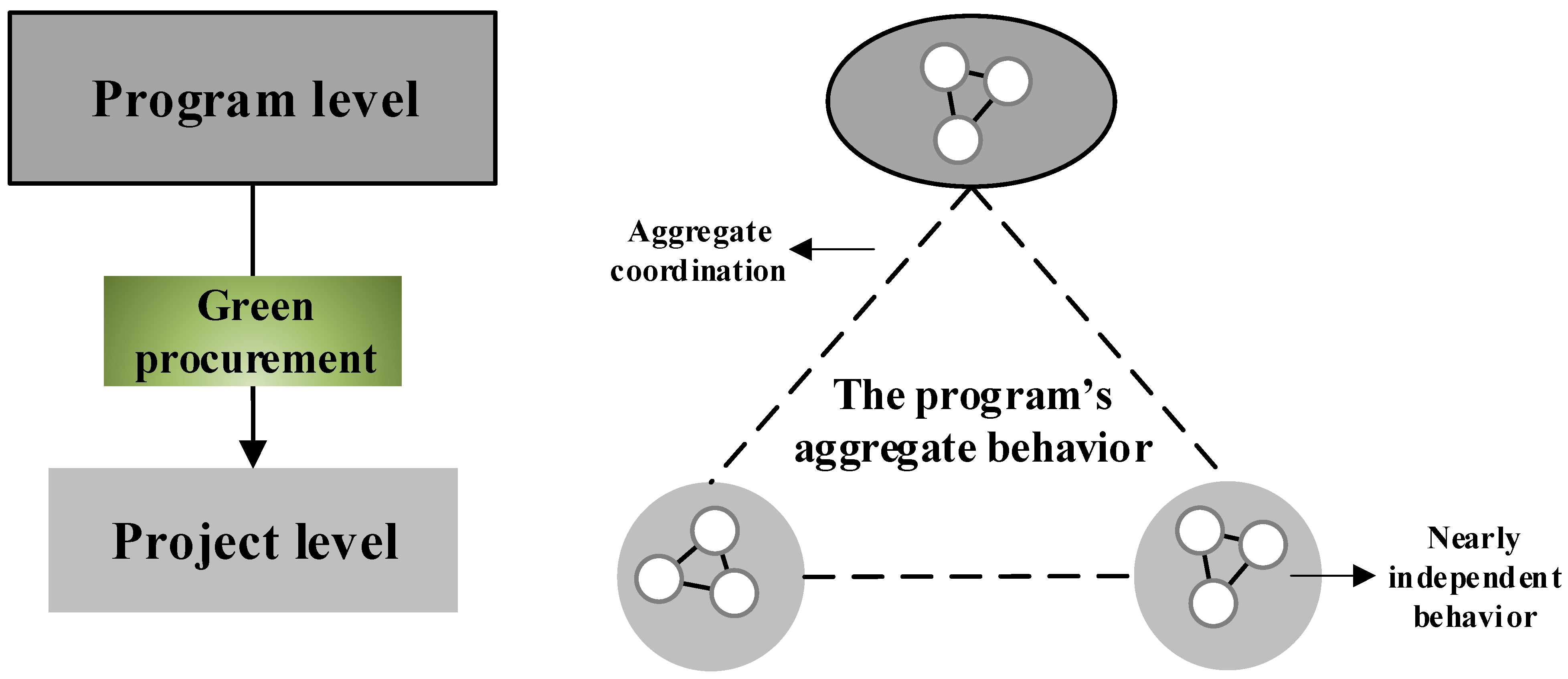
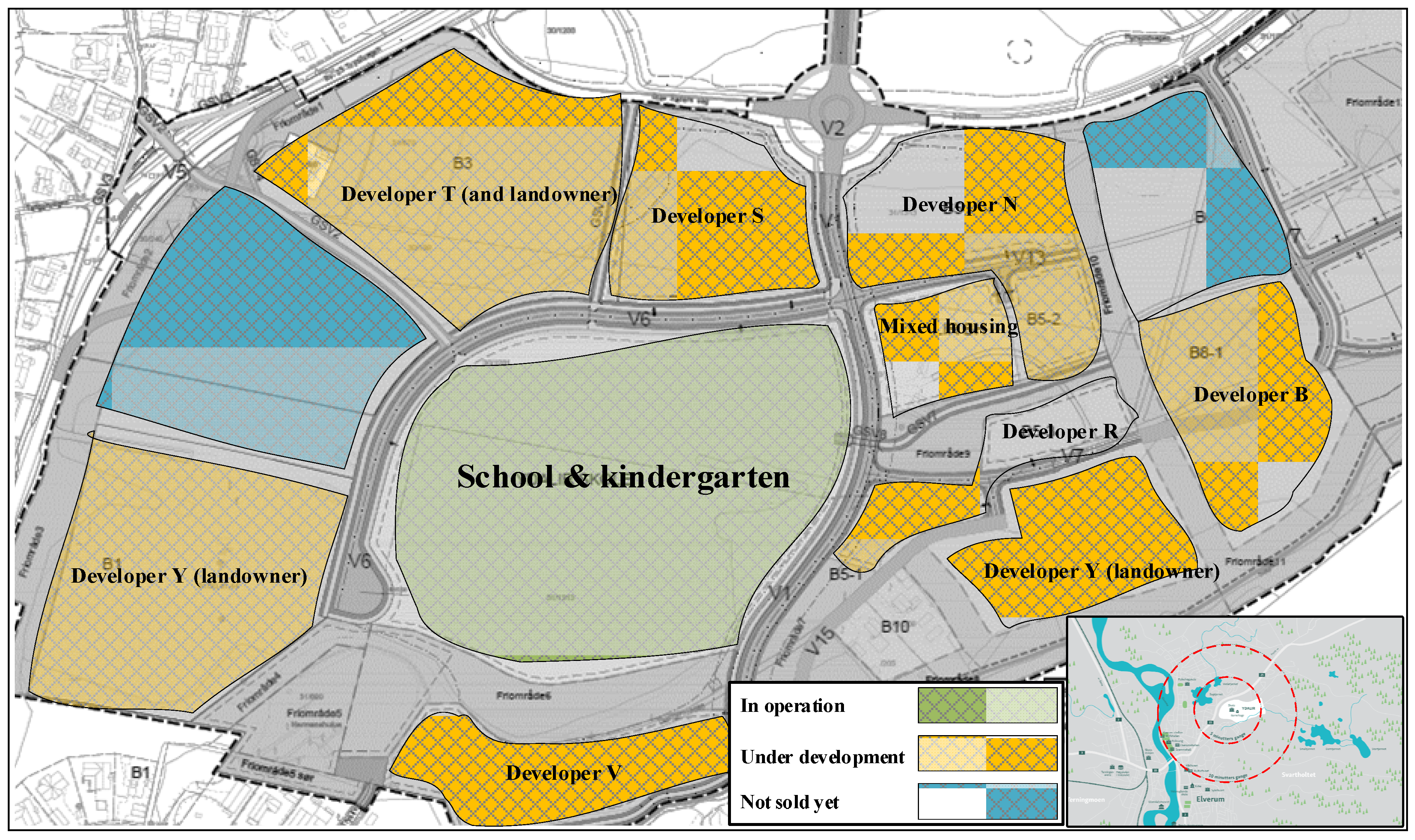
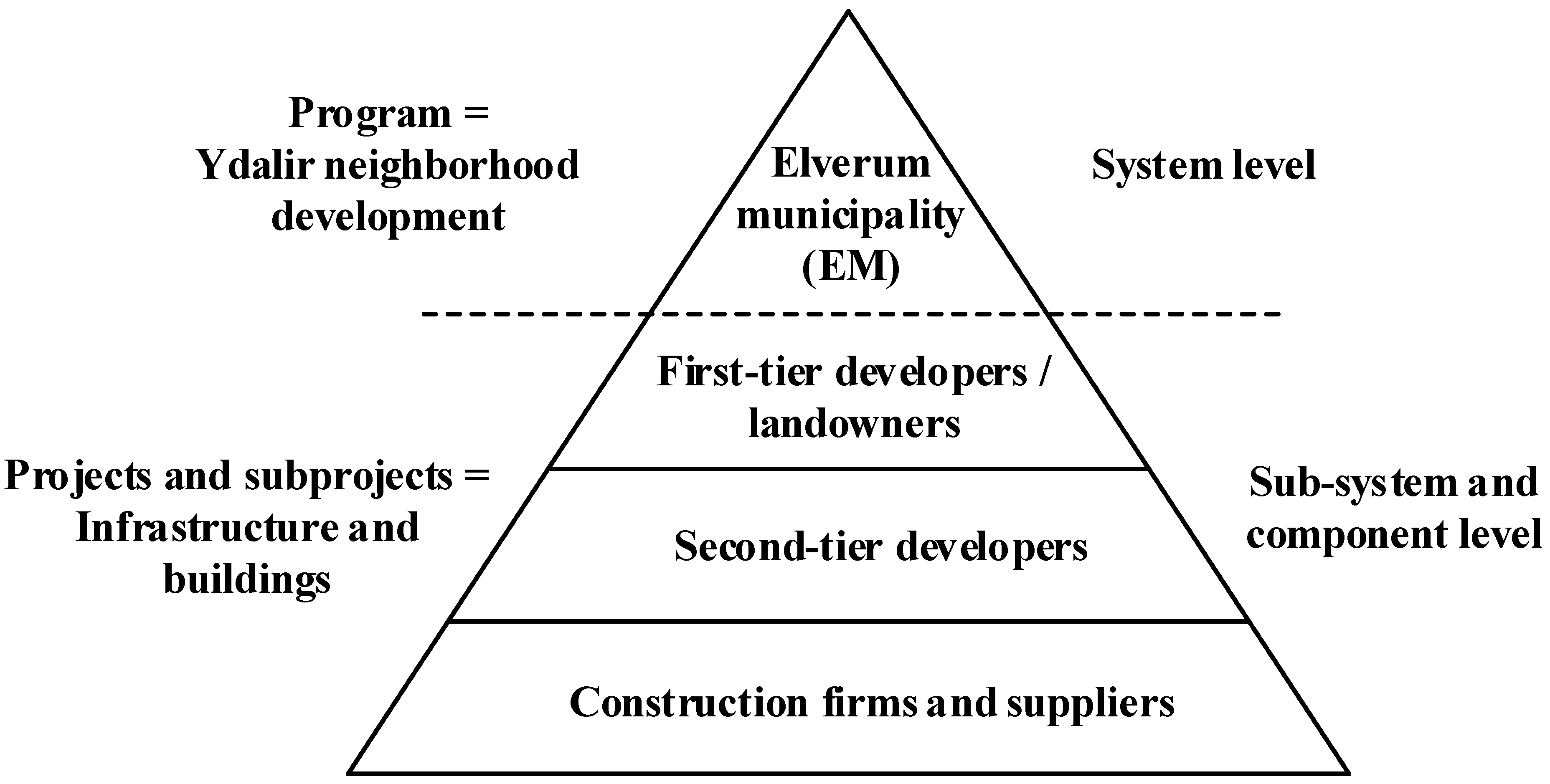
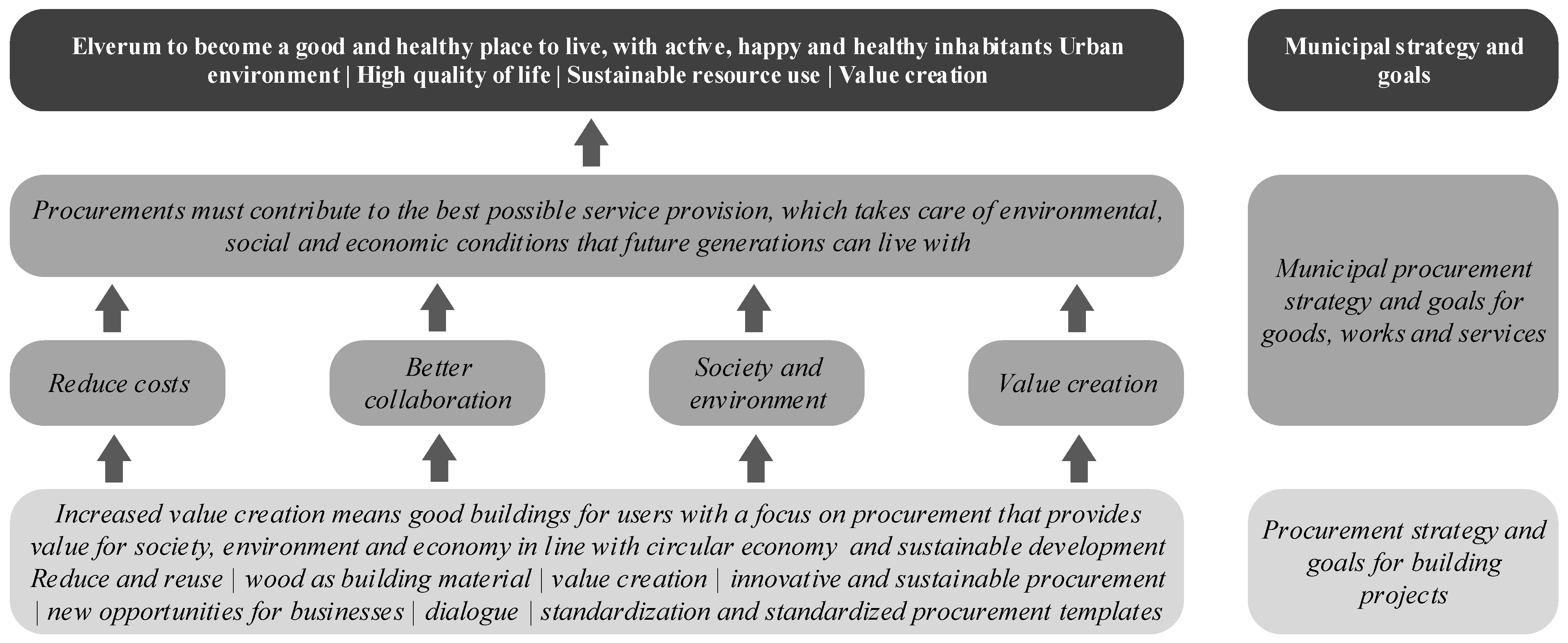
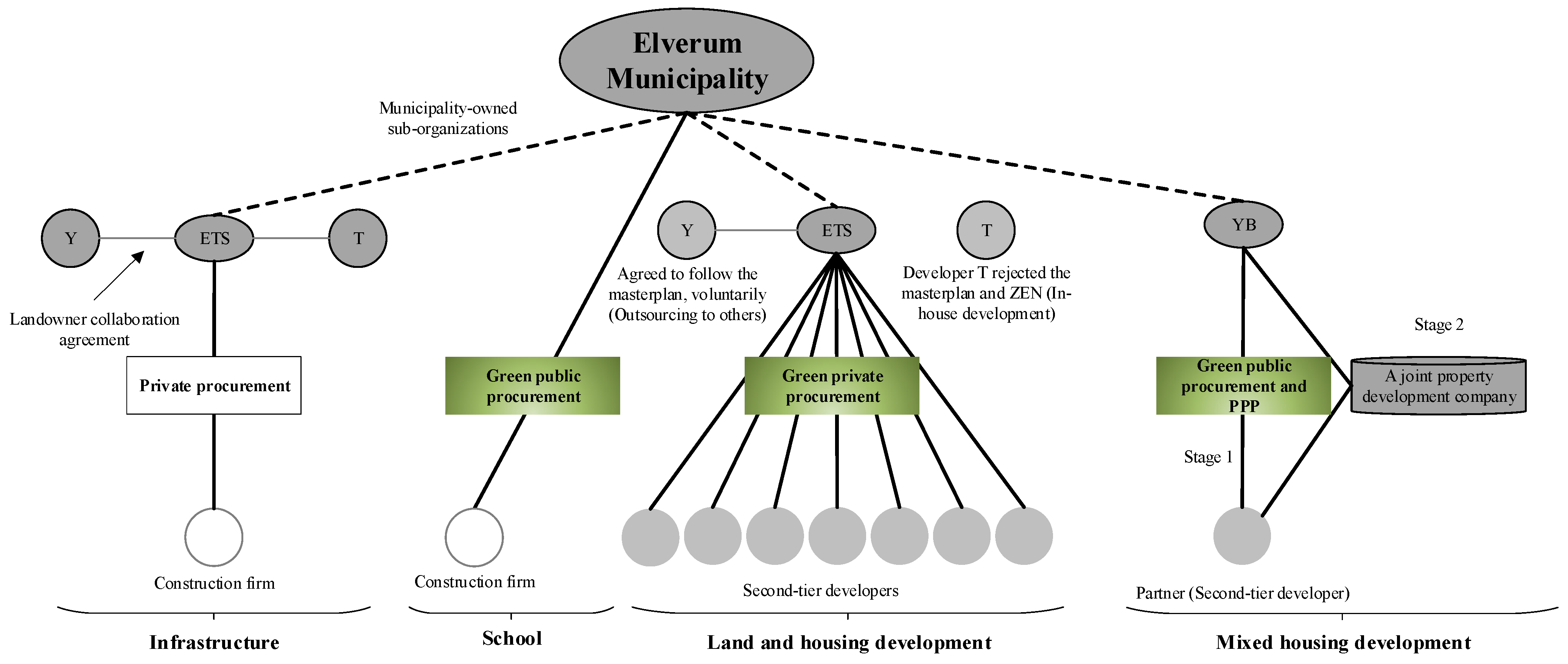
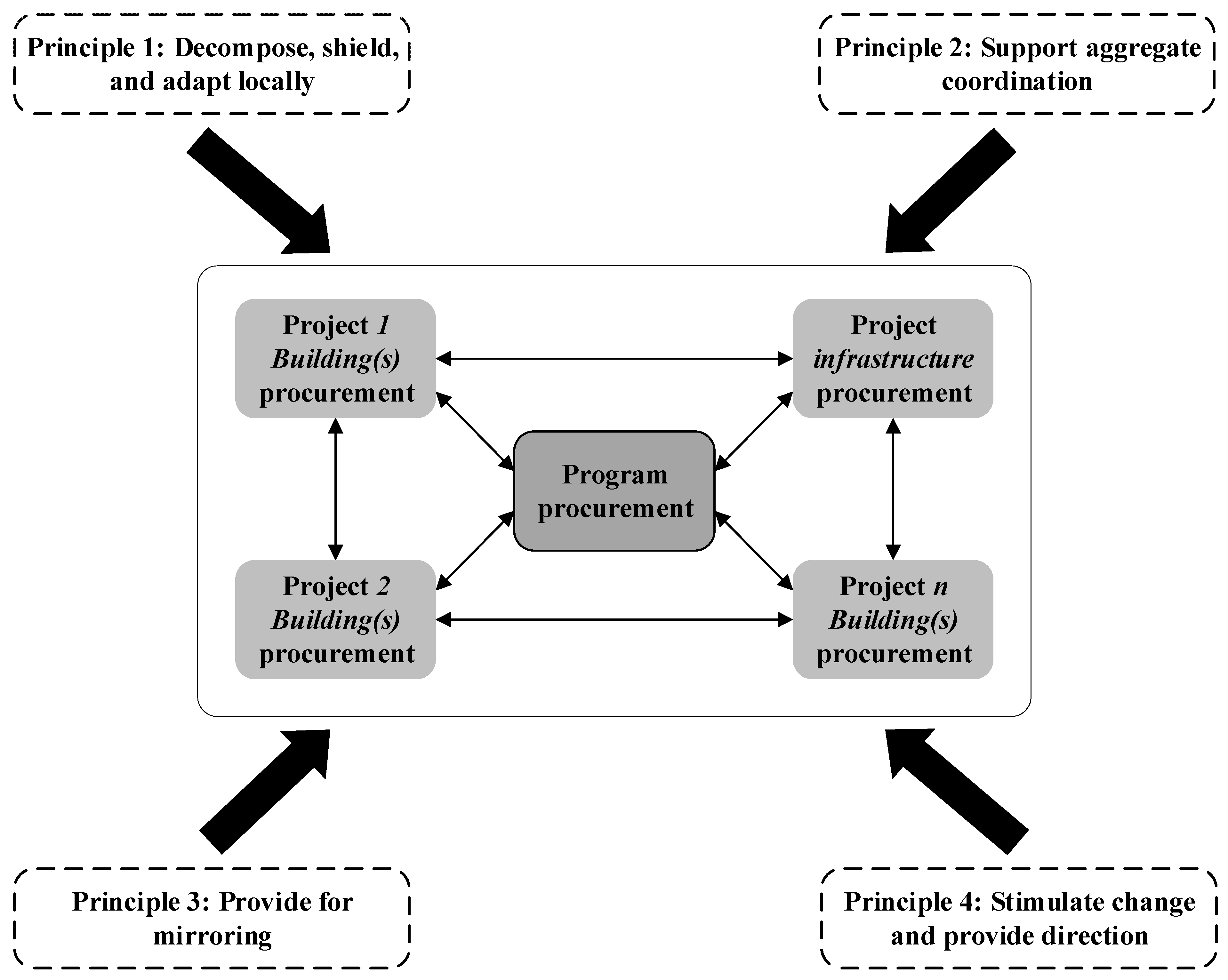
| Stage 1 (2017) | Stage 2 (2019/2020) | |
|---|---|---|
| Objectives | Focus on early-stage activities, visions, objectives, risks, development plans, potential stakeholders, and challenges | Focus on project development, organizing, green procurement and contracting processes, and collaboration agreements |
| Primary sources | Nine interviews ETS (1), EM (3), developers Y and N (2), energy and transportation companies (2), architect (1) | Thirteen interviews ETS (4), EM (5), developers Y, N, T, and V (4) |
| Secondary sources | Municipal documents and presentations (e.g., announcements and workshop summaries) Internal project documents (e.g., agreements, contracts, feasibility study reports) | Municipal documents and presentations (e.g., municipal and procurement strategy documents) Internal project documents (e.g., agreements, contracts) News articles and research reports |
| Informant roles | Project manager (PM), purchasing manager (PuM), general manager (GM), construction projects manager (CPM), spatial planning manager (SPM), communication manager (CM) | |
| Project | Scope | Type | Time | Dialogue | EM Role | Inclusion of the Masterplan’s Green Requirements |
|---|---|---|---|---|---|---|
| Infrastructure | It covered roads, waste, water, electricity, and district heating | Private procurement | 2016–2019 | None. | Indirect | The actual work started before the formulation of the masterplan -no measures are related to climate and environment |
| School and kindergarten | Design and construction of buildings for school, kindergarten, sports hall, and outdoor facilities | Public procurement | 2017–2019 | Dialogue meetings/conferences, negotiated tendering, and interaction-based contract model | Direct | The masterplan was under development at the time of this procurement, but it covered many aspects of the masterplan. -zoning plans (i.e., introducing ZEN ambitions) -green ambitions are communicated in the dialogue meeting (e.g., wood as building material). EM introduced Ydalir as ZEN -BREEAM very good as a minimum -energy (i.e., passive house standard) -building and material (i.e., passive house standard, environmentally friendly materials with low GHG emission) -mobility (i.e., facilitates for environmentally friendly means of transport: walking, cycling, and possibly vehicles) |
| Land and housing developments | Each project includes zoning, design, construction, and sales of housing units. Projects cover 9 different land lots scattered around the school | Private procurement | 2017–2030 | Five dialogue workshops. | Indirect | Strictly follows the masterplan. It was included and attached to contracts as an obligatory element. -overall planning (i.e., green infrastructure, buried waste systems) -building and material (i.e., passive house standard, environmentally friendly materials with low GHG emission, Environmental Product Declaration-EPD) -mobility (i.e., encourage bicycles and public transport, reduced parking lots, EV charging, car-sharing arrangements) -energy (i.e., passive house standard, solar cells, carbon accounting) |
| Mixed housing development | Financing, developing, construction, and selling 12 care homes (for younger people with disabilities) and ordinary housing. Shared parking and short-term parking for kindergarten | Public procurement and PPP | 2020–2022 * | Dialogue meeting, negotiated tendering process, PPP contract model | Hybrid | The procurement goals and specifications are positioned to be in line with the masterplan -zoning plans (i.e., introducing ZEN ambitions) -green ambitions are communicated in the dialogue meeting -the masterplan was part of the tendering documents |
Publisher’s Note: MDPI stays neutral with regard to jurisdictional claims in published maps and institutional affiliations. |
© 2021 by the authors. Licensee MDPI, Basel, Switzerland. This article is an open access article distributed under the terms and conditions of the Creative Commons Attribution (CC BY) license (http://creativecommons.org/licenses/by/4.0/).
Share and Cite
Hamdan, H.A.M.; de Boer, L.; Baer, D. When Green Procurement Meets Complexity: The Case of Sustainable Neighborhood Projects. Sustainability 2021, 13, 2116. https://doi.org/10.3390/su13042116
Hamdan HAM, de Boer L, Baer D. When Green Procurement Meets Complexity: The Case of Sustainable Neighborhood Projects. Sustainability. 2021; 13(4):2116. https://doi.org/10.3390/su13042116
Chicago/Turabian StyleHamdan, Hasan A. M., Luitzen de Boer, and Daniela Baer. 2021. "When Green Procurement Meets Complexity: The Case of Sustainable Neighborhood Projects" Sustainability 13, no. 4: 2116. https://doi.org/10.3390/su13042116
APA StyleHamdan, H. A. M., de Boer, L., & Baer, D. (2021). When Green Procurement Meets Complexity: The Case of Sustainable Neighborhood Projects. Sustainability, 13(4), 2116. https://doi.org/10.3390/su13042116







